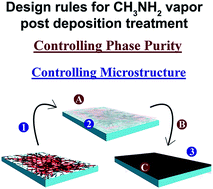Design rules for the broad application of fast (<1 s) methylamine vapor based, hybrid perovskite post deposition treatments†
Abstract
While organo-metal halide perovskite photovoltaics have seen rapid development, growth of high quality material remains a challenge. Herein, we report a facile post deposition treatment utilizing coordination between methylamine (CH3NH2) vapor and CH3NH3PbI3 perovskite that rapidly improves film quality, enhancing power conversion efficiency (PCE) by ∼9%. We further comprehensively analyze the physical impact of this process with regard to the material's optoelectronic properties and its detailed microstructural changes. Connecting this with an analysis of the source of organo-metal halide perovskite reactivity toward the vapor as well as phase behavior as a function of CH3NH2 vapor pressure and time, we provide design rules for the broad, rational extension of this process to new systems and scales.


 Please wait while we load your content...
Please wait while we load your content...